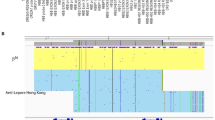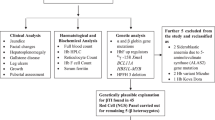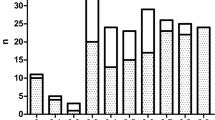Abstract
GENETIC evidence suggests that the haemoglobin (Hb) α chain genes are duplicated in at least some human populations, as a number of individuals are known to have two different α chain variants in addition to HbA (ref. 1). Furthermore the presence of two α chain genes per haploid genome has been demonstrated in a few cases using direct measurement by DNA hybridisation2,3. However, this may not be true of all racial groups, particularly the Melanesian populations in which HbJ Tongariki is found. Abramson et al.4 and Beaven et al.5 described five individuals who were apparently homozygous for this α chain variant, none of whom had any detectable HbA. α Thalassaemia was discounted on haematological grounds, and it was concluded that some, if not all, Melanesians have only one α chain locus. However, as recent studies have shown that two of the common forms of α thalassaemia are due to α gene deletion6–8, the disease must be quite rigorously excluded before the number of α gene loci can be deduced solely on the basis of genetic evidence. We have studied again the family described by Beaven et al., and other unrelated individuals, all of whom live on Karkar Island, off the northern coast of Papua New Guinea. By determination of α/β mRNA ratios in these individuals we have obtained evidence which strongly suggests that they are in fact homozygous for an α thalassaemia gene.
This is a preview of subscription content, access via your institution
Access options
Subscribe to this journal
Receive 51 print issues and online access
$199.00 per year
only $3.90 per issue
Buy this article
- Purchase on Springer Link
- Instant access to full article PDF
Prices may be subject to local taxes which are calculated during checkout
Similar content being viewed by others
References
Lang, A. & Lorkin, P. A. Br. med. Bull. 32, 239–245 (1976).
Old, J. M., Longley, J. I., Wood, W. G., Clegg, J. B. & Weatherall, D. J. Nature 269, 524–528 (1977).
Tolstoshev, P. et al. Eur, J. Biochem. 78, 161–165 (1977).
Abramson, R. K., Rucknagel, D. L., Schreffler, D. C. & Saave, J. Science 169, 194–196 (1970).
Beaven, G. H., Fox, R. H. & Hornabrook, R. W. Phil. Trans. R. Soc. B 268, 269–277 (1974).
Ottolenghi, S. et al. Nature 251, 389–392 (1974).
Taylor, J. M. et al. Nature 251, 392–393 (1974).
Kan, Y. W. et al. Nature 255, 255–256 (1975).
Hunt, T. Br. med. Bull. 32, 257–261 (1975).
Weatherall, D. J. & Clegg, J. B. The Thalassaemia Syndromes (Black-well Scientific, Oxford, 1972).
Weatherall, D. J., Clegg, J. B., Na-Nakorn, S. & Wasi, P. Br. J. Haemat. 16, 251–267 (1969).
Weatherall, D. J. & Clegg, J. B. Phil. Trans. R. Soc. B 271, 411–455 (1975).
Hornabrook, R. W., Crane, G. G. & Stanhope, J. M. Phil. Trans. R. Soc. B268, 293–308 (1974).
Old, J. M. et al. Cell 8, 13–18 (1976).
Ottolenghi, S. et al. Proc. natn. Acad. Sci. U.S.A. 72, 2294–2299 (1975).
Author information
Authors and Affiliations
Rights and permissions
About this article
Cite this article
OLD, J., CLEGG, J., WEATHERALL, D. et al. Haemoglobin J Tongariki is associated with α thalassaemia. Nature 273, 319–320 (1978). https://doi.org/10.1038/273319a0
Received:
Accepted:
Issue Date:
DOI: https://doi.org/10.1038/273319a0
This article is cited by
-
Association between a common immunoglobulin heavy chain allele and rheumatic heart disease risk in Oceania
Nature Communications (2017)
-
High frequency of triplicated α-globin loci and absence or low frequency of α thalassemia in Polynesian Samoans
Human Genetics (1985)
-
?-Thalassemia and the production of different ? chain variants in heterozygotes
Biochemical Genetics (1981)
Comments
By submitting a comment you agree to abide by our Terms and Community Guidelines. If you find something abusive or that does not comply with our terms or guidelines please flag it as inappropriate.



